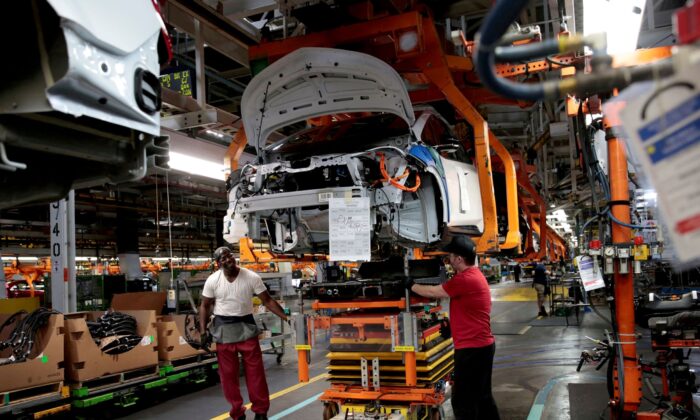
global battery economy is poised to transform into the “new oil” and will alter international supply chains, say Morgan Stanley analysts in a report.
Equity analysts at the investment bank forecast that the battery economy could climb to $500 billion within the next two decades. This, they note, would be supported by greater penetration of battery-powered electric vehicle sales, projected to account for nearly one-third of the global market by 2030.
so-called new oil is considered a “cross asset” that “sits at the nexus of equity sectors, ESG, commodities, and public policy,” adding that “these drivers contribute to an industrial ‘flywheel’ that accelerates capital formation, lowers costs, and, ultimately, provides a path to commercial scale.”
Market observers warn of multiple challenges that would prevent industry sales from surging to 50 percent. For example, Morgan Stanley noted that battery-cell supply chain development, public policy, and hydrogen fuel cells would establish significant hurdles for the sector.
“We may be being conservative, and it is possible that the rate of transition accelerates further. However, limiting factors on our forecasts remain the ability of the legacy auto industry to accelerate further; battery cell and drivetrain supply chain development; government legislation changes (outside of Europe and China); competing technologies, such as hydrogen fuel cells; and infrastructure investment,” Morgan Stanley analysts said in the report.

Officials at the Wall Street titan also questioned how prepared the global automobile industry would be for this dramatic shift in the marketplace. Be it high capital expenditure and swelling restructuring costs, analysts note that these “concerns are well understood,” which could facilitate a successful transition since businesses know they need to grapple with these issues.
Morgan Stanley has become bullish this year in the EV battery realm. bank has been expanding its coverage of the overall EV industry, monitoring developments in new design and production capabilities.
“As we survey the EV/battery startup landscape, we are prioritizing highly differentiated technology and/or business models with a path to scale at a reasonable level of risk,” said Adam Jonas, a Morgan Stanley automotive analyst, in a note.
In addition to Tesla Motors, Norsk Hydro, and QuantumScape, the company has also listed Fisker, FREYR, and Microvast as businesses to track. Morgan Stanley thinks other firms would play a critical role in the battery economy, too, such as mining firm Glencore, chemical manufacturing giant Albemarle, and multinational industrial manufacturer Komatsu.
EV Battery Demand Intensifying
Earlier this month, more than a dozen of the world’s largest automobile companies pledged to accelerate a suite of electric products and sales through 2030. From Volkswagen to General Motors, they plan to spend more than $500 billion over ten years.
This, market observers note, would lead to surging demand for both EV batteries and the raw materials necessary for manufacturing.
It is estimated that approximately two-thirds of international battery-cell output capacity is concentrated in China. While demand has swelled in the United States and Europe, production has fallen behind. Still, a growing number of corporations are committing to billions of dollars worth of EV battery manufacturing investment.
In March, LG Chem pledged $4.5 billion to expand its EV battery capabilities. This past spring, Ford and SK Innovation announced a joint venture—BlueOval Sk—to manufacture 60 GWh annually in traction battery cells and array modules. Last month, Toyota earmarked $3.4 billion to enhance EV battery output.
“Once a few manufacturers announced EV programs, everyone else had to announce their own or be viewed as being left behind,” Brian Maxim, head of global powertrain forecasting at AutoForecast Solutions, recently told Reuters. “This leaves a lot of vehicle manufacturers planning significant volumes for a vehicle category that has unknown consumer acceptance, and will have minimal to no profit” for a long time.
se massive investments do not include the billions of dollars already being poured into extra production capacity, much of which has been made in cooperation between the largest battery companies and automakers.
U.S. government is also spending billions in taxpayer dollars on the electric vehicle push, from nationwide charging stations to tax credit incentives. As part of President Joe Biden’s $1.75 trillion Build Back Better Agenda that was passed last week, the legislation includes $6 billion in federal grants to support businesses producing batteries or processing materials for EV battery components.
In April, the Biden administration celebrated “a win for American workers and the American auto industry” after LG Energy Solution and SK Innovation, two South Korean electric vehicle battery makers ended a long-running trade dispute. As a result, LG will establish a $2.6 billion battery factory in Georgia.
Overall, the positive trend for the industry is that the cost of producing lithium-ion battery packs has declined substantially over the last decade. U.S. Department of Energy data show that the prices had fallen 87 percent between 2008 and 2020. This, according to BloombergNEF, has brought the average price of battery to $137 per kilowatt hour (kWh). Once this cost slides below $100 per kWh, electric vehicles would be as affordable as combustion engine cars, BloombergNEF economists assert.
Pezou : Morgan Stanley: EV Batteries Are the ‘New Oil’